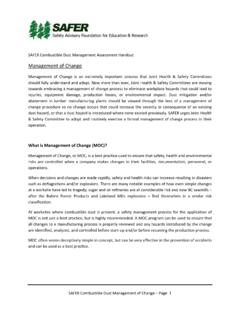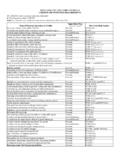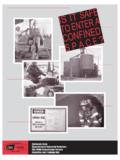Transcription of Implementing Combustible Dust Procedures
1 Implementing Agenda Procedures Organizational Issues Combustible DUST Housekeeping Ignition Source Control Procedures Hazard Communication Training Administrative Procedures Personal Protective Equipment Equipment Maintenance Gary Q. Johnson, Management of Change Workplace Exposure Solutions Emergency Procedures & Incident Reporting May 6, 2011. Copyright Gary Q. Johnson 2011. 1 2. Key Elements: Implementing a Combustible Dust Program Building Organizational Ownership? Build Organizational Ownership? Convincing management and operators that: Procedures Equipment A dust explosion or dust fire could happen here Hazard assessment Designs that meet regulatory Regulatory enforcement is active now Dust testing requirements The problem won't go away Flame resistant clothing Class II electrical equipment? Charter company resources to: Ch t t Operator training Static grounding, bonding Conduct Gap Analysis to characterize hazards and Housekeeping Hot surfaces, friction?
2 Mitigation strategies Ignition source control Dust collection systems Implement Combustible dust Procedures Equipment maintenance Vacuum cleaning Engineer equipment changes to mitigate risk Firefighting, emergency Explosion prevention, protection, Put resources in place to sustain results Management of Change isolation Compliance audits Damage limiting construction 3 4. 1. Can a Combustible dust explosion occur here? Major Catastrophes, Common Materials Dust Explosion Pentagon 1995 Malden Mills nylon fiber Fire Triangle . plus Two 1999 Jahn Foundry foundry molding compound Heat or Ignition 1999 Ford River Rouge coal dust 2002 Rouse Polymerics rubber 2003 West Pharma. polyethylene dust Chemical Chain Reaction 2003 CTA Acoustics ceiling tiles Oxidant (Air) Fuel 2003 Hayes Lemnerts aluminum wheels 2008 Imperial Sugar household sugar New Fire Triangle Overview 5 6.
3 Imperial Sugar Dust accumulations were fuel for building wide deflagrations Dusty Environments Can Become: 7 8. 2. Fuel for Dust Clouds with Housekeeping Density > MEC. The hazards associated with cleaning Safe cleanup methods Manual Vacuum cleaning Housekeeping Procedures Contractor cleanup Summary Pneumatic conveying system leak like dust cloud from compressed air blow down . cannot see 3-4 feet thru cloud 9 10. Back to the Dust Explosion Pentagon: Cleanup Dust Explosion Scenario Multiple Strategies to Reduce Cleanup Risk Heat or ignition source: prevent static electricity, Overhead settled dust create sparks dense dust cloud > MEC during cleaning Dispersion of dust particles: prevent Confinement of dust Static electrical spark hose to dust layer getting cloud: building &. building structure ignite this airborne clean up equipment designed to dense dust cloud (other method?)
4 Safelyy contain or vent ignitiion sources possible . bl hot h surface, flame). Exploding cloud dislodges other settled dust to propagate deflagration Expanding deflagration gases destroy building Combustible dust (fuel): prevent Oxidizer (oxygen in air): accumulation reduce O2 with inert gas housekeeping (asphyxiation hazard?). 11 12. 3. Cleanup Methods Safe compressed air blow down NFPA 654: Section Vacuum all accessible dust Safe conditions for compressed air blow vacuum cleaners listed for use in Class II locations down De energize any electrical Sweeping equipment not rated for Class II locations Water wash down Cool any hot surfaces capable of igniting dust Vacuum cleaning cloud Portable vacuum cleaners (PVC) Use 15 psi steam or compressed air Central vacuum cleaning systems (CVC) Vacuum up remaining dust 13 14. Safe sweeping Water wash down.
5 Water wash down what pressure? Sweep gently to minimize airborne dust Natural bristles (no Fog or mist synthetic) wets dust Aluminum or Hard spray conductive polymer pumps air . pumped air dust pans column create dust cloud? 15 16. 4. Water wash down versus dry? Portable Vacuum Cleaner . Portable Vacuum Cleaner Air Powered Advantages Disadvantages Static dissipating Increases conductivity of Safe way wet down first, features dust layer reduce static then spray down electricity -Drum grounding Trickle down mess . cable If done right, minimizes widespread cleanup Combustible dust cloud Where does residue end up -Conductive vacuum and can that area be and air hoses cleaned? -Conductive wheels How water tight is YOUR electrical system? Courtesy Vac-U-Max 17 18. Portable Vacuum Cleaner . Portable Vacuum Cleaner Electric Central Vacuum Cleaning Systems System components -High vacuum producer (6-12 Hg =.)
6 82-164 ). -Filter/receiver -Pre-separator HEPA filter (optional). -Tubing branches to use zones -Hoses and tools Courtesy Vac-U-Max Courtesy Gardner Denver Courtesy Gardner Denver Electrical Classification II, Div 1. 19 20. 5. Use the CVC tools designed for your Elements of Effective problem! Floors Housekeeping Designated responsibilities Pipes Survey areas with unacceptable Adequate resources accumulation (FM 7 76 Safe cleaning methods useful to assess hazard) Routinely document results Look for opportunities to B ildi l d i 6 o Building clean design: 60. Equip- eliminate dust sources sloped surfaces, box in Crevices ment (overhead accumulations structural steel, etc. greatest concern ie, structural steel beams Routine management reviews might have horizontal of housekeeping schedule to surface area 10% of floor) ensure focus and continuous improvement Open end of hose has limited reach job takes longer.
7 Tools designed for high velocity scrubbing power 21 22. Dust Layer Where, How Much? NFPA 654: Annex D. Lightly discolored ~ 1/64 layer Assessing Dust Layer Hazard Proportion of building Dust layer allowable thickness varies with dust with layer bulk density: Floor area > 5% up to 1/32 layer basis for hazardous 20,000 ft2, 1000 ft2. condition maximum? Density 75 #/ft3, MEC=350 gm/m3. 1/32 cover floor => dust cloud 10 Overhead dusty areas 5 . feet high, dense enough for dust 10% floor? deflagration Bar joists and beams AT(inches)=((1/32)*75#/ft3)/(ac tual density#/ft3) Walls BD = 36: AT= 1/8 Piping and conduit BD = 18: AT = 3/32 1/16 1/32 . 23 24. 6. NFPA 654: Allowable Dust NFPA 654 TIA Changes 2011. Accumulation, table Layer Depth Criterion Not deflagration hazard if < 1/64 or surface color discernable Accumulation frequency: Infrequent (2 3 episodes/year) 1/32 LDC can be adjusted by dust bulk density = 1/32 x ( Frequent (>3 episodes/yr or within 24 hours) #/ft3).
8 Continuous (faster than 24 hours). Housekeeping frequency: Dust Deflagration Hazard <1/32. <1/32 . 1/8. 1/8 infrequent . infrequent SAME SHIFT Bldg < 20,000 ft2, > 5% of area > LDC. Bldg < 20 000 ft2 > 5% of area > LDC. <1/32 1/8 frequent OFTEN ENOUGH TO KEEP LAYER Bldg > 20,000 ft2, 1000 ft2 max > LDC. AVG 1/16 . > 1/8 SHUT DOWN AND CLEAN UP IMMEDIATELY Process Equipment Explosion Hazard Electrical classification: Sufficient comb. dust to rupture equipment if suspended and ignited Infrequent at least dust tight 1/32 > 1/8 frequent Class II, Div. 2 Means of suspending dust is present > 1/8 infrequent Class II, Div 2 Personnel exposed to deflagration hazard shall be protected > 1/8 frequent Class II, Div 1. with flame resistant clothing (NFPA 2113). 25 26. FM 7 76 (Prevention and Mitigation Clean Design Concepts to Minimize of Combustible Dust Explosions and Overhead Dust Accumulations Fire): Assessing Dust Layer Hazard 60o slopes on Hazard exists in 10 ft high building if: horizontal surfaces > 5% of area has >1/16 dust layer Enclose structural Electrical Dust bulk density assumed = 36 #/ft3 Cable Tray steel Equation for different conditions for suspendible E ti f diff t diti f dibl dust above floor or floor dust that could be Solid deck plates Enclosed disturbed versus open grating I-Beam Tex = HxAtot/( ).
9 H = height of room, ft Atot = total area, 20,000 ft2 upper limit Spills from one level to the ADust = area with suspendible dust (bar joists, beams, next through open grating piping, conduit, light fixtures can be 5 10% of floor area) become fugitive dust 27 28. 7. Overhead Oscillating Fans Tool to Typical Layout of Overhead Fan Matrix Minimize Dust Layers High in Room (Multiple OOF to Cover Ceiling) Areas). Center of Fan Units Best application: light weight dusts like textiles or paper dust 29. 30. Comparison of Pro's and Con's Determining Cleanup Frequency Clean up area with care to avoid ignition risks note Advantages Disadvantages areas where layer is thicker Easy to install; low maintenance Doesn't reduce dust in the air just Purchase 9x9 baking pans, weigh them and mark the stops it collecting on surfaces tare weight Oscillating vertical cleaning radius Correct number & location of fans Low power consumption 400v 3 Low power consumption required to achieve full benefits Suspend these pans in the areas where the dust was phase @ kw/ hr Some dead spots due to overhead thicker Very effective in overhead dust obstructions elimination Fans need to be left working when in Routinely monitor pan dust layer to get data on how Significant reduction/elimination of production.
10 Run 24/7 fast your dust settles Increased volume of dust deposited on overhead cleaning/costs the floor & lower levels Clean up before the layer exceeds the allowable Significant reduction in overhead Initial cost and installation (turn key) ~ layer cleaning risk and liability $5 6 K per fan Significant reduction of fire risk Running costs (low but still incurred). Introduction 31 32. 8. Hiring a Cleaning Contractor Hiring a Cleaning Contractor Questions you should ask Questions the contractor should be asking Employee training given and up to date? Certifications from Chilworth or NFPA? What are the Combustible dust properties, Experience with Combustible Dust cleanup? including Minimum Ignition Energy? Does the Membership in industry organizations? p y g MSDS describe Combustible Dust hazards? What precautions do you take to What are your plant's safety Procedures and Wh t l t' f t d d Prevent static electricity buildup?







